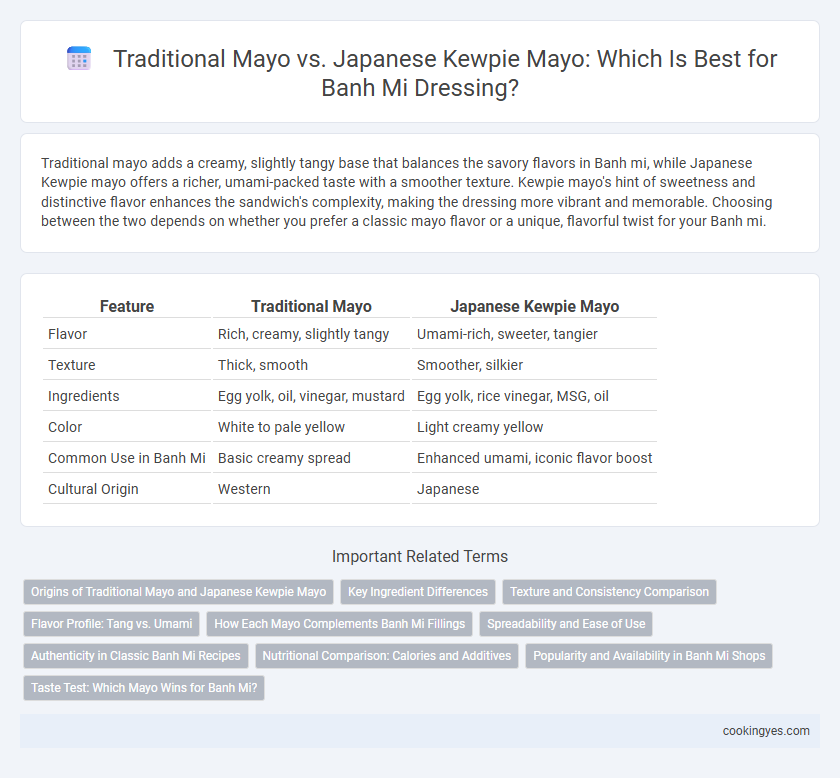Traditional mayo adds a creamy, slightly tangy base that balances the savory flavors in Banh mi, while Japanese Kewpie mayo offers a richer, umami-packed taste with a smoother texture. Kewpie mayo's hint of sweetness and distinctive flavor enhances the sandwich's complexity, making the dressing more vibrant and memorable. Choosing between the two depends on whether you prefer a classic mayo flavor or a unique, flavorful twist for your Banh mi.
Table of Comparison
| Feature | Traditional Mayo | Japanese Kewpie Mayo |
|---|---|---|
| Flavor | Rich, creamy, slightly tangy | Umami-rich, sweeter, tangier |
| Texture | Thick, smooth | Smoother, silkier |
| Ingredients | Egg yolk, oil, vinegar, mustard | Egg yolk, rice vinegar, MSG, oil |
| Color | White to pale yellow | Light creamy yellow |
| Common Use in Banh Mi | Basic creamy spread | Enhanced umami, iconic flavor boost |
| Cultural Origin | Western | Japanese |
Origins of Traditional Mayo and Japanese Kewpie Mayo
Traditional mayo originates from Western cuisine, typically made with egg yolks, oil, vinegar, and lemon juice, creating a creamy and tangy base ideal for sandwiches like Banh mi. Japanese Kewpie mayo, inspired by the traditional recipe, uses only egg yolks for a richer texture and incorporates rice vinegar for a mild, slightly sweet flavor profile. This variation enhances the Banh mi dressing by adding a smooth, umami-rich layer that complements the sandwich's bold, fresh ingredients.
Key Ingredient Differences
Traditional mayo for Banh mi uses a base of egg yolks, oil, vinegar or lemon juice, and mustard, creating a creamy yet tangy flavor. Japanese Kewpie mayo differs by incorporating rice vinegar, apple cider vinegar, and a higher concentration of egg yolks, resulting in a richer, slightly sweeter taste. The umami flavor from Kewpie's added MSG enhances the overall depth, making it a popular choice for an authentic and flavorful Banh mi dressing.
Texture and Consistency Comparison
Traditional mayo features a creamy and smooth texture with a moderate thickness that enhances Banh mi without overpowering the other ingredients. Japanese Kewpie mayo offers a richer, silkier consistency due to its higher egg yolk content and rice vinegar, creating a slightly tangier and more velvety dressing. This distinct texture delivers a balanced moisture that complements the crispy baguette and fresh vegetables in Banh mi, making it a preferred choice for a more indulgent experience.
Flavor Profile: Tang vs. Umami
Traditional mayo offers a tangy flavor profile with a slight acidity that brightens the Banh mi's rich ingredients, creating a refreshing contrast. Japanese Kewpie mayo delivers a distinctive umami depth thanks to its use of egg yolks and rice vinegar, enhancing the sandwich's savory notes and adding creaminess. Choosing between the two influences the overall taste experience, with traditional mayo highlighting sharpness and Kewpie emphasizing a smooth, savory richness.
How Each Mayo Complements Banh Mi Fillings
Traditional mayo offers a creamy, slightly tangy flavor that enhances the savory, pickled, and fresh ingredients in Banh Mi, balancing the richness of meats like pork or chicken. Japanese Kewpie mayo, known for its umami depth and subtle sweetness, intensifies the Banh Mi's flavor profile, complementing spicy chilies and fresh herbs while adding a luxurious texture. Both mayos serve to unify the sandwich's diverse elements, but Kewpie's richer taste uniquely elevates the overall eating experience.
Spreadability and Ease of Use
Traditional mayo offers a creamy texture but can be thicker and less easy to spread evenly on a banh mi baguette. Japanese Kewpie mayo features a smoother, silkier consistency with a richer umami flavor, allowing for effortless spreading and better absorption into the bread. Its fine texture enhances the overall balance of flavors without overpowering the sandwich, making it the preferred choice for achieving a perfectly dressed banh mi.
Authenticity in Classic Banh Mi Recipes
Traditional mayo provides a creamy, neutral base that complements the vibrant flavors of classic Banh Mi sandwiches without overpowering the other ingredients. Japanese Kewpie mayo offers a richer, slightly sweet and tangy profile with a velvety texture, enhancing the sandwich's depth while maintaining authenticity. Both mayonnaises deliver distinct nuances, but Kewpie mayo aligns closely with traditional Vietnamese palates, adding a subtle umami twist prized in authentic Banh Mi recipes.
Nutritional Comparison: Calories and Additives
Traditional mayo typically contains around 90 calories per tablespoon and includes basic ingredients such as eggs, oil, vinegar, and salt. Japanese Kewpie mayo, known for its richer flavor and creamier texture, often has slightly higher calories, approximately 100 per tablespoon, due to added MSG and rice vinegar, which enhance umami without artificial preservatives. Both mayos offer similar fat content, but Kewpie mayo's unique additives contribute to a more complex taste profile, making it a popular choice for authentic Banh mi dressing.
Popularity and Availability in Banh Mi Shops
Traditional mayo offers a familiar creamy texture that many Banh Mi shops use due to its broad availability and cost-effectiveness. Japanese Kewpie mayo, known for its rich umami flavor and slightly sweeter profile, has surged in popularity among gourmet Banh Mi vendors seeking to elevate the sandwich's taste. Despite higher pricing, Kewpie mayo is becoming increasingly accessible in urban Banh Mi shops, reflecting consumer demand for premium ingredients.
Taste Test: Which Mayo Wins for Banh Mi?
Traditional mayo offers a creamy, tangy base with a balanced richness, while Japanese Kewpie mayo delivers a smoother texture and a subtle umami flavor from its rice vinegar and egg yolk ingredients. In taste tests for banh mi dressing, Kewpie mayo enhances the sandwich's savory elements without overpowering the fresh herbs and pickled vegetables. This umami-forward profile often wins over traditional mayo by providing a more complex and harmonious flavor experience that complements the classic banh mi.
Traditional mayo vs Japanese Kewpie mayo for Banh mi dressing Infographic

 cookingyes.com
cookingyes.com